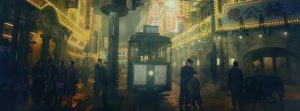Posted: May 14th, 2017 | No Comments »
Saturday, May 20: “The Wild Ming Tombs, a guided tourâ€
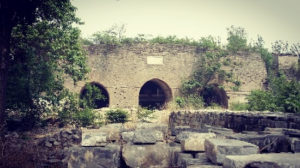
You’re invited to view with fresh eyes the imperial necropolis north of Beijing –- which even today inspires tomb robbers and tales of imperial excess –- featuring sites rarely seen on the usual tours. We’ll trace the footsteps of emperors travelling to the Ming Tombs, stopping at the partially restored ruins of Gong Hua Cheng, a garrison town where imperial entourages rested, before passing by the Spirit Way and visiting the imperial tomb Zhaoling. We’ll see the lonely grave of the last Ming Emperor’s loyal eunuch, who stayed by his master in death as in life, as well as burial sites of concubines and an empress. The tour includes a 15-dish village lunch, and a stop at one of Beijing’s last imperial tile factories, which produces the colorful roof tiles and animal-shaped ornaments seen on tomb structures and other imperial architecture. Commentary will be provided in English by Ming and Qing history specialist Zhu Wei of the Chinese Academy of Cultural Heritage, part of the Chinese World Heritage Center, with additional comments (and translation if needed) by RASBJ officers.
WHAT: A “Wild Ming Tombs†tour with commentary by Zhu Wei
WHEN: Saturday, May 20, 09:00 AM – 18:30 PM
HOW MUCH: Members RMB 250, non-members RMB 300, which includes the cost of the bus and audiophones, Zhaoling entry tickets, lunch and an honorarium to Zhu Wei. Please pay no later than May 18 via yoopay at https://yoopay.cn/event/38347308 or via wechat to  johnobeijing (he’ll have to friend you first) and please write “RASBJ Wild Tombs†plus names of attendees being paid for.
TRANSPORT: The bus leaves from outside the Hilton Hotel, east 3rd Ring Road, near Liangmaqiao subway stop, at 09:00 AM and returns there around 18:30 PM, depending on traffic.
RSVP: email communications.ras.bj@gmail.com and write “Wild Tombs†in the subject header, with attendees’ names and cell numbers
IMPORTANT:
- Attendees will be limited to 12; RASBJ members have priority until Wednesday, May 17.
- Members will be accepted on a first-come-first-served basis until May 17; payment is due May 18. Each can ask to reserve one seat (for himself or herself) plus up to three others. Due to limited seating, it may not be possible to guarantee that non-members -– even relatives or friends of members –- can be accommodated.
- Non-Members may apply no later than May 17, and will be informed ASAP if seats are/become available.
- Between May 15-19 RASBJ will email those with confirmed seats.
- Payment is required by noon May 18. Seats requested but not paid for by May 18 will be given to others.
Please dress appropriately, with footwear suitable for walking on uneven ground

Posted: May 13th, 2017 | No Comments »
My latest for the Los Angeles Review of Books China blog – the arduous task of having lunch with Frances Wood and talking about books from China and her own new Great Books of China….honestly, how we suffered….click here to read

Posted: May 12th, 2017 | No Comments »
Fleischmann’s Yeast was once a very well known and heavily advertised American brand of yeast. Since its heyday in before the war it’s gone through many changes of ownership though still exists. The company was founded and originally based in Cincinnati. Interestingly it used Shanghai in its advertising in the 1920s….This ad from 1923…..
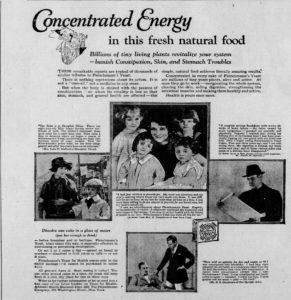
and here’s our lovely yeast-enhanced Shanghailander couple….
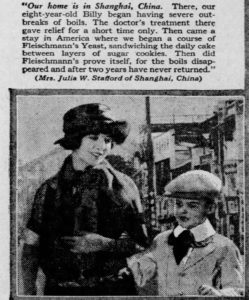 Here is the testimonial from Mrs Julia W. Stafford of Shanghai regarding her eight-year-old son Billy – have to say the picture looks a little flapper-age photo-shopped (which was possible – just flick through Cecil Beaton’s work). The picture may be a bit doctored but Julia is real enough…Julia (nee Wright) Stafford was the wife of the Treasurer for the East China Mission (American Baptist missionaries) based in Shanghai, Roy Davis Stafford. He had met Julia, a Vasser graduate, when she was editor of the Helping Hand magazine (a Baptist missionary publication). They apparently had a large centrally located house in the Settlement and had arrived in the city since in 1909.
Here is the testimonial from Mrs Julia W. Stafford of Shanghai regarding her eight-year-old son Billy – have to say the picture looks a little flapper-age photo-shopped (which was possible – just flick through Cecil Beaton’s work). The picture may be a bit doctored but Julia is real enough…Julia (nee Wright) Stafford was the wife of the Treasurer for the East China Mission (American Baptist missionaries) based in Shanghai, Roy Davis Stafford. He had met Julia, a Vasser graduate, when she was editor of the Helping Hand magazine (a Baptist missionary publication). They apparently had a large centrally located house in the Settlement and had arrived in the city since in 1909.
However, Julia’s testimonial has been around for some time – this ad/endorsement appeared in the American newspapers in 1923 claiming Billy as eight – meaning he was born in 1915. However, there are references in Shanghai to Billy Stafford back in 1912 as a baby – he was actually born in 1911 in Shanghai. Seems Fleischmann’s had been ‘recycling’ Julia’s testimonial for some time. Incidentally Billy had a brother, Mial Davis Stafford, born in Shanghai in December 1918 and a sister. At the end of the 1920s the family left Shanghai to live in Berea, Kentucky, where Julia’s husband was the Treasurer of Berea College. Billy died in New York in 1983 at 72 years of age: Mial died in Georgia in 2008 at 90.
The use of Mrs Stafford is not accidental – In the 1920s Shanghai, and all China potentially, was becoming a major new market for yeast and for Fleischmann’s brand. This news hot off the press in 1924 (and with more than China Rhyming moment for this old China retail market analyst!) – growth in popularity in fresh bread, yeast plants near Shanghai, the move from rice to flour….remember this was 1924 – as they say ‘don’t hold your breath’!!
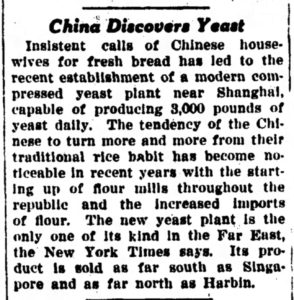
Posted: May 11th, 2017 | No Comments »
A public talk in London that might interest China Rhyming readers…
China’s Asian Dream: Empire Building Along the New Silk Road
Tom Miller

In this talk, Tom Miller talks about his new book, China’s Asian Dream: Empire Building Along the New Silk Road.
“China”, Napoleon once remarked, “is a sleeping lion. Let her sleep, for when she wakes she will shake the world.” In 2014, President Xi Jinping triumphantly declared the lion had awakened. Under his leadership, China is pursuing a dream to restore its historical position as the dominant power in Asia.
Combining a geopolitical overview with on-the-ground reportage from a dozen countries, China’s Asian Dream offers a fresh perspective on the rise of China’ and what it means for the future of Asia?
| When |
Mon 15 May 2017, 5:00pm – 7:00pm |
| Where |
Room B111, Brunei Gallery, SOAS University of London |
| Open to |
Students, scholars, public, alumni |
| Registration |
Free, no booking required |
Posted: May 10th, 2017 | 1 Comment »
News this week that much of the shikumen clusters along Sinza Road (now Xinzha Lu), that run from the street down to the Suzhou Creek, are empty and awaiting demolition.This area of 1920s housing has suffered repeated blows – in 2013 traditional lilong were demolished around Datian Road near Xinzha Road (below); more has gone to allow for the subway station and various other nondescript high rises. Things turned nasty back then over compensations – some families had lived in Sinza for over 70 years, even back before World War Two. They were all sent off to Jiading and that area is a hi-rise now ( the pics below from early 2013).


and this is what replaced it…

This is bad news for several reasons: 1) Xinzha Road’s “residential district” is a cluster of shikumens that are now among the last intact clusters left and show (as once did the vandalised and bastardised Xin Tian Di and Jian Ye Li, as well as numerous other once) the original architectural styles of the city; 2) the recent plans issued by the Shanghai government and various foreign architects detailing “preservation” along the Suzhou Creek are worthless; 3) that Shanghai will lose more of its dwindling stock of unique architecture (shikumens and lilongs do not exist in any meaningful sense anywhere outside Shanghai) which is akin to architectural extinction; 4) enough with the jerry built tower blocks already; 5) I would expect the new tower blocks developer to enclose the bankside of the Creek and therefore further limit access to the waterway for pedestrians (this is already a problem on the north side of the Creek and has long been true of large swatches of the southern side that are impassable to pedestrians – once again showing how various government/foreign developer plans are BS) and; 5) Sinza has a long and interesting history that has been largely forgotten already and will now be erased from the collective memory and formal history. So a few historical notes on Sinza; the first being well known and the last perhaps not so…
Sinza was of course within the International Settlement – as well as being the name given to a street and police post it was also a sub-district, people referred to Sinza as a place, an area, a district. Sinza is derived from the Chinese word for New Toll Gate (11 miles up the Soochow Creek from ‘Louza’, the Old Toll Gate). Close by the residential shikumen cluster now being bulldozed the main street was home to, among many other offices and businesses, the China Inland Mission, who, in 1930, moved their headquarters to 1531 Sinza Road to co-ordinate all their missionary work across China. The Victorian-style 1531 building complex (below), complete with lots of arches and pillars grouped around an extensive compound, was also home to the China Inland Mission Hospital. The six-storey Home Block had the Prayer Meeting Hall in the centre with a hospital and its staff residences as well as a home for missionaries passing through Shanghai. The Sinza Police Station, built in 1899 on the road, was always known as the Sinza Road Station.

The Sinza Bridge, across the Creek, also still exists in a modern form but has been in operation for well over a century in previous forms (below)…

Sinza Road was also the last place many Shanghailanders ever arrived in the city before disappearing underground – MacDonald’s was one of the Settlement’s major undertakers…

I could go on listing former residents and businesses, but there’s also a more hidden history of Sinza, from World War Two…
In 1940 the Japanese had not taken over the Settlement formally (pre-Pearl Harbor), but they were expanding their influence. As well as the Little Tokyo district, across the Creek in Hongkou, Sinza became a major target for their activities. In November 1940 Japanese army linked interests opened the Asia Club in the district and Sinza into a new street of sin that was a mini0-version of the infamous Shanghai Badlands to the west of the city. The Asia Club offered gambling with opium smoking divans upstairs. The rookeries and lanes of the Sinza shikumen cluster now being demolished became a Badlands in miniature – kidnap gangs and hold-up men lodged in its deep, dark lanes incognito among the many brothels that sprung up. Standover men followed the punters in to rip off their profits at gunpoint. There were gun battles nightly in Sinza. Hwa-Wei (lottery) parlours, grind joints (low end casinos), Philopon (methamphetamine) distribution shacks with Yakuza shabu merchants from Tokyo, plus a cabaret with all-transvestite taxi-dancers appears overnight. The Japanese Gendarmes patrolled from Gordon Road (Jiangning Road) across a couple of blocks, and a hundred alleyways, along Sinza as far as Tatung Road (Xinqian Road). The Shanghai Municipal Police effectively kept out of Sinza and the Sinza Road Municipal Police Station became a ghost town.
That was Sinza through to 1945 when it reverted to a residential district again….
Mini-Badlands; residential compound – it’s now all just about to be rubble…..
Posted: May 9th, 2017 | No Comments »
I’m going to give a quick plug to a book that sounds fascinating but I’m afraid I (and most of you) can’t read. Still it’s out there and we should know about stuff whatever the language….
Frode Olsen’s Ikke en Jordisk Chance (Not An Earthly Chance) is in Danish, but hopefully might get an English translation….

A dramatic documentary report about a group of brave Danes forgotten efforts during World War II. As posted in Hong Kong, the Danes were captured, Japan put a massive attack into the crown colony. And several of them chose to stand up as volunteers on the British side instead of sitting with their hands in the lap – and paid for their lives. They never had a mortal chance.
The attack on Hong Kong and the one and a half million inhabitants lasted 18 days. When the British colony surrendered on Christmas Day 1941, 1,500 Allied soldiers and 4000 civilians had lost their lives, including at least two Danes. Right from the very first day, the crooked colony of the crown had not had the slightest chance of opposing an absurd overpowered and fierce Japanese battleground. And yet, they stood up and kept on until the last forces were used. It also applied to Danes. Far from the country of origin, they took part in a war for which they were neither responsible nor part of.
This is the story of the dramatic days, weeks and months in Hong Kong, their opposition and, by the way, is seen through the eyes of Denmark and, to the fullest extent possible, with the people’s own words. The book is based on letters, pictures and interviews with family members of the Danish volunteers in Hong Kong.
“After two weeks of charging for war with Blackouts, long and scary night guards, it’s just like I’m used to the idea of ​​killing, smashing and avoiding getting a bayonet at all. There were almost no thoughts Who could become familiar with the beginning, but now it’s coming! “
– Niels Ørskov, Danish volunteer in Hong Kong’s diary, December 24, 1941.
The reviewers write:
It is a world-historical account of Hong Kong’s fall to the Japanese. But it is also – the source material of letters from the protagonists and interview with family members – a deeply poignant book about young Danes who put themselves at risk to ensure a free world.
Tor Tolstrup, 6 stars, Jyllands-Posten
“It is also very good to say about Olsen’s book. It is well-written, well-researched and well-illustrated. There is so much lavishness of relevant cards, photos, figures, and more that the reader almost gets the feeling that Keep a genuine coffee table book in your hands. “
Michael Busch, 4 stars, Christian newspaper
“In relative terms, the Danish efforts were small, but the volunteer Danes in Allied service are a remarkable story, and Frode Z. Olsen tells them well. The Danes could have gone away on time, but they chose to even sign up for voluntary military service .
Frode Z. Olsen finally dares – rightly – to call them heroes. It is a beautiful book with excellent illustrations and thorough source material, and it is reminiscent of the Danes and others who in a difficult situation where the defeat seemed safe and they did not have a chance risked their lives. “
Bent Blüdnikow, Berlingske, 5 stars
“With no earthly chance Frode Z. Olsen has done a solid historical work, as if its theme is also a pioneer work.”
Henrik Gjøde Nielsen, Museum Inspector, PhD, Coast Museum , History-online.dk
Read the full review here
“Not a mortal chance is a good, well-researched book about a minor chapter of the Great War – with a manifold number of fate stories.”
Bo Bjørnvig, Weekendavisen
“I think it was an exciting and incredible book to read. The author writes good, the text is well-formulated and easy to read. It is clear that he is both in military terms, as well as the culture and history of the area.”
Bach’s books
NB:
Danish citizens living abroad can buy the book by writing to simon@turbine.dk. Then the book will be sent along with an invoice.
Posted: May 8th, 2017 | No Comments »
Should you happen to be Oxford this Monday, an event on Chinese in Britain with Anne Witchard and Daniel York….
From Yellow Peril to Yellowface: the Cultural Politics of the Chinese Diaspora in Britain
2017/05/08 Monday 5pm Lecture Theatre 1, China Centre, St Hugh’s College
Starting from this Trinity term, the Oxford Chinese Studies Society will host a series of public events on global Chinese culture, through which we hope to engage more with Chinese cultural workers from all over the world in the fields of literature, film, theatre and more. In this first event in the series, we have invited Chinese-British playwright/actor Daniel York and literary scholar Dr. Anne Witchard to talk about the cultural politics of the Chinese diaspora in Britain. This event will be of interest to those of you who work on East-West relations, race and colonialism, Asian diaspora and identity politics in general. Each speaker will talk for around 15 minutes and we will leave plenty of time for Q & A and discussions.
Dr. Anne Witchard: “The Chinese Girlâ€â€™: Sinophilia and the Construction of Modernist Femininities in 1920s London
Anne Witchard is Reader in the Department of English Literature and Cultural Studies at the University of Westminster. She is one of the leading scholars in the studies of Sino-British connections in modern literature. Her publications include Thomas Burke’s Dark Chinoiserie: Limehouse Nights and the Queer Spell of Chinatown (Ashgate, 2007), Lao She in London (Hong Kong University Press, 2012) and England’s Yellow Peril: Sinophobia and the Great War (Penguin, 2014). She is editor of London Gothic: Place, Space and the Gothic Imagination (with Lawrence Phillips) (Continuum, 2010) and Modernism and British Chinoiserie (Edinburgh University Press, 2015).
Daniel York: Protest and Performance: The Lie of British East Asian Invisibility in the Arts
Daniel York is a successful scriptwriter, director and actor who is passionate about championing equal rights for creative East Asians. His plays and theatre works in London include Song Of Four Seasons, Fake Chinaman In Rehab, The Fu Manchu Complex. As an actor, his feature films include Rogue Trader, The Beach (directed by Danny Boyle) opposite Leonardo Di Caprio and the action film Doom starring The Rock.
Posted: May 8th, 2017 | No Comments »
China Rhyming readers may be interested to know that the fourth installment of my Crime and the City series for The Literary Hub visits Shanghai – old Shanghai crime, contemporary writing and true crime books all included…..
click here
